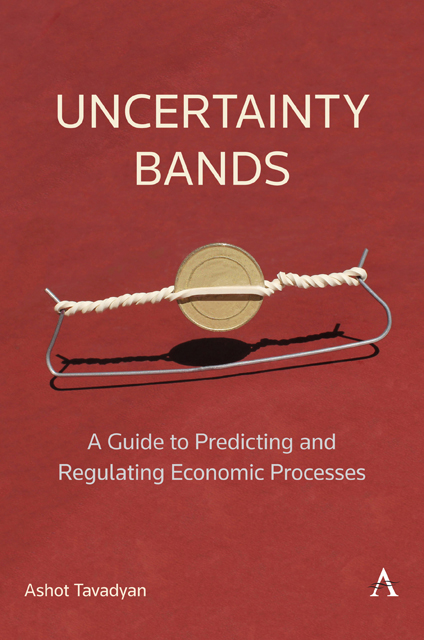Book contents
- Frontmatter
- Contents
- Preface
- Introduction: The Philosophy of Economic Forecasting
- 1 Interval Links in Economy and the Capabilities of Quantitative Thinking
- 2 The Possibilities for Forecasting Economic Indicators
- 3 The Principle of the Minimal Uncertainty Interval
- 4 The Intervals of Key Economic Indicators
- 5 Key Principles of Economic Regulation
- Conclusion
- Appendix: The Uncertainty Relations of Economic Indicators
- Acknowledgments
- Index
4 - The Intervals of Key Economic Indicators
Published online by Cambridge University Press: 09 December 2022
- Frontmatter
- Contents
- Preface
- Introduction: The Philosophy of Economic Forecasting
- 1 Interval Links in Economy and the Capabilities of Quantitative Thinking
- 2 The Possibilities for Forecasting Economic Indicators
- 3 The Principle of the Minimal Uncertainty Interval
- 4 The Intervals of Key Economic Indicators
- 5 Key Principles of Economic Regulation
- Conclusion
- Appendix: The Uncertainty Relations of Economic Indicators
- Acknowledgments
- Index
Summary
The Systematization of Economic Indicators
Conditions for stable economic development
Target indicators
Systematization of key indicators with the detection of their uncertainty intervals is a necessary condition for an efficient economic policy. Key indicators constitute nodes that link economic processes into one system. Links of key indicators accumulate other connections of economic processes and present them in a summarized form. The U.S. government estimates around 45,000 economic variables, and nongovernmental sources keep track of at least four million data. In this case, many of the formulated variables will be of minor importance.
Thus, it is necessary to present the nodes, which summarize other variables to obtain tolerable results in the study of economic causations. This system approach should be carried out using a combination of economic objectives, normative constraints and the basic principles of regulation in the economy.
The system approach and a precise mating of key economic indicators are exceptionally important for economic development. Unfortunately, there are numerous examples of inconsistencies. For example, adherence to the principle of price stability often turns into a tough, inflexible monetary policy. Not enough attention is often paid to its feedback, that is, the explicit impact on GDP, structure of GDP, exports and employment.
In the most concentrated form, the key indicators are given and legislated in the so-called Magic square. In 1967, Germany adopted the Act to Promote Economic Stability and Growth, which formulated the basic principles of economic policy to avoid a subjective approach. Those principles for the key indicators, which are required as the basis for the preparation of budgets and financial planning, are as follows: steady economic growth, balanced foreign trade, a high level of employment and price stability. The “Magic square” represents the key indicators of an economy in a concentrated form. They must be considered in a single system. An attempt to single out a sole indicator with no regard to its causations to other key indicators will not yield a quality result, especially in the long run.
Goodhart's law may snap into action if the monetary policy is represented by a single indicator. Once a government or a central bank starts using a sole indicator, its significance may not match the economic reality.
- Type
- Chapter
- Information
- Uncertainty BandsA Guide to Predicting and Regulating Economic Processes, pp. 41 - 62Publisher: Anthem PressPrint publication year: 2022



